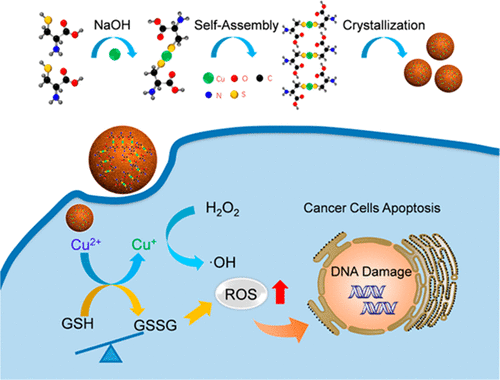当前位置:
X-MOL 学术
›
J. Am. Chem. Soc.
›
论文详情
Our official English website, www.x-mol.net, welcomes your
feedback! (Note: you will need to create a separate account there.)
Self-Assembled Copper-Amino Acid Nanoparticles for In Situ Glutathione “AND” H2O2 Sequentially Triggered Chemodynamic Therapy
Journal of the American Chemical Society ( IF 14.4 ) Pub Date : 2018-12-13 , DOI: 10.1021/jacs.8b08714 Baojin Ma 1 , Shu Wang 2, 3 , Feng Liu 1 , Shan Zhang 1 , Jiazhi Duan 1 , Zhao Li 1 , Ying Kong 1 , Yuanhua Sang 1 , Hong Liu 1, 4 , Wenbo Bu 5, 6 , Linlin Li 2, 3
Journal of the American Chemical Society ( IF 14.4 ) Pub Date : 2018-12-13 , DOI: 10.1021/jacs.8b08714 Baojin Ma 1 , Shu Wang 2, 3 , Feng Liu 1 , Shan Zhang 1 , Jiazhi Duan 1 , Zhao Li 1 , Ying Kong 1 , Yuanhua Sang 1 , Hong Liu 1, 4 , Wenbo Bu 5, 6 , Linlin Li 2, 3
Affiliation

|
Nanoformulations that can respond to the specific tumor microenvironment (TME), such as a weakly acidic pH, low oxygen, and high glutathione (GSH), show promise for killing cancer cells with minimal invasiveness and high specificity. In this study, we demonstrate self-assembled copper-amino acid mercaptide nanoparticles (Cu-Cys NPs) for in situ glutathione-activated and H2O2-reinforced chemodynamic therapy for drug-resistant breast cancer. After endocytosis into tumor cells, the Cu-Cys NPs could first react with local GSH, induce GSH depletion, and reduce Cu2+ to Cu+. Subsequently, the generated Cu+ would react with local H2O2 to generate toxic hydroxyl radicals (·OH) via a Fenton-like reaction, which has a fast reaction rate in the weakly acidic TME, that are responsible for tumor-cell apoptosis. Due to the high GSH and H2O2 concentration in tumor cells, which sequentially triggers the redox reactions, Cu-Cys NPs exhibited relatively high cytotoxicity to cancer cells, whereas normal cells were left alive. The in vivo results also proved that Cu-Cys NPs efficiently inhibited drug-resistant breast cancer without causing obvious systemic toxicity. As a novel copper mercaptide nanoformulation responsive to the TME, these Cu-Cys NPs may have great potential in chemodynamic cancer therapy.
中文翻译:

用于原位谷胱甘肽“AND”H2O2 顺序触发化学动力学疗法的自组装铜氨基酸纳米颗粒
可以对特定肿瘤微环境 (TME) 做出反应的纳米制剂,例如弱酸性 pH、低氧和高谷胱甘肽 (GSH),有望以最小的侵袭性和高特异性杀死癌细胞。在这项研究中,我们展示了自组装的铜氨基酸硫醇盐纳米颗粒(Cu-Cys NPs)用于原位谷胱甘肽激活和 H2O2 增强的耐药性乳腺癌化学动力学疗法。内吞进入肿瘤细胞后,Cu-Cys NPs 可以首先与局部 GSH 反应,诱导 GSH 消耗,并将 Cu2+ 还原为 Cu+。随后,生成的 Cu+ 将与局部 H2O2 反应,通过类芬顿反应生成有毒的羟基自由基 (·OH),该反应在弱酸性 TME 中反应速度快,是导致肿瘤细胞凋亡的原因。由于肿瘤细胞中高浓度的 GSH 和 H2O2 依次触发氧化还原反应,Cu-Cys NPs 对癌细胞表现出相对较高的细胞毒性,而正常细胞则保持存活。体内实验结果也证明Cu-Cys NPs能有效抑制耐药乳腺癌,且不会引起明显的全身毒性。作为一种对 TME 有反应的新型硫醇铜纳米制剂,这些 Cu-Cys NPs 在化学动力学癌症治疗中可能具有巨大的潜力。
更新日期:2018-12-13
中文翻译:

用于原位谷胱甘肽“AND”H2O2 顺序触发化学动力学疗法的自组装铜氨基酸纳米颗粒
可以对特定肿瘤微环境 (TME) 做出反应的纳米制剂,例如弱酸性 pH、低氧和高谷胱甘肽 (GSH),有望以最小的侵袭性和高特异性杀死癌细胞。在这项研究中,我们展示了自组装的铜氨基酸硫醇盐纳米颗粒(Cu-Cys NPs)用于原位谷胱甘肽激活和 H2O2 增强的耐药性乳腺癌化学动力学疗法。内吞进入肿瘤细胞后,Cu-Cys NPs 可以首先与局部 GSH 反应,诱导 GSH 消耗,并将 Cu2+ 还原为 Cu+。随后,生成的 Cu+ 将与局部 H2O2 反应,通过类芬顿反应生成有毒的羟基自由基 (·OH),该反应在弱酸性 TME 中反应速度快,是导致肿瘤细胞凋亡的原因。由于肿瘤细胞中高浓度的 GSH 和 H2O2 依次触发氧化还原反应,Cu-Cys NPs 对癌细胞表现出相对较高的细胞毒性,而正常细胞则保持存活。体内实验结果也证明Cu-Cys NPs能有效抑制耐药乳腺癌,且不会引起明显的全身毒性。作为一种对 TME 有反应的新型硫醇铜纳米制剂,这些 Cu-Cys NPs 在化学动力学癌症治疗中可能具有巨大的潜力。






























 京公网安备 11010802027423号
京公网安备 11010802027423号